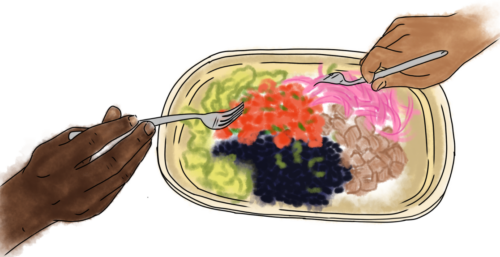In the culinary world, there seem to be two opposite realms: the casual, crave-worthy indulgence of “munchies” and the meticulously crafted masterpieces of Michelin-starred dining. At first glance, the two could not be further apart—one is messy, quick, and easy; the other is precise, time-consuming, and technically arduous. The former could be viewed as artless, while the other gains praise as true art.
But is that divide really so clear-cut? Will McKibben ’25 doesn’t think so. A professional chef and member of the Signet Society for his work in the culinary arts, McKibben brings both technical training and philosophical depth to the kitchen. While working under award-winning chef Finn Walter at the West Texas restaurant, The Nicolett, he not only sharpened his skills but also developed a mindset that would come to shape both his cooking and his outlook on life.
“The main driving philosophy behind everything I do in cooking…is intentionality,” McKibben said, sharing advice from Walter. “Whatever you do, you should be completely pure in the intention behind it…There’s a misconception that fine dining chefs have this crazy palette—that if it’s not caviar, crème fraîche, then I don’t want it—which is just really far from the truth. It’s more about whatever you’re trying to do, do it well,” he continued.
This perspective challenges the hierarchy we’ve come to accept around food. One might expect a reverence for formality in the culinary world, but instead, McKibben lights up when talking about one of Harvard Square’s most beloved late-night spots.
“I love El Jefe’s. I think it’s great,” he said. “Why? Because the intention behind their food is to be [for] a drunk, slutty night—and they do it, and they do it really well. Not everything needs to be fine dining.”
McKibben reframes food not by how it looks, but by how well it fits its intended purpose—how intentional all of its components are.
“I think also in a lot of contemporary fine dining, that gets lost—a lot of doing things just for show, just because it looks cool,” he continued. “And Finn told me—he was like, any dish that you make, you—or any chef—should be able to come up and point to something and say, ‘Why is this here?’ And you should have a really strong answer. If the dish doesn’t need that component, it shouldn’t be there.”
One might assume that fine dining is inherently artistic, with complex presentations showcasing meticulous beauty and precision. But in reality, presentation is only a single element that makes cooking artful.
“When you begin to stretch the intentionality of the food you’re making into the realm of the cerebral, that’s when presentation begins to matter,” McKibben explained.
In fine dining, presentation isn’t just about aesthetics—it’s about how every component of a dish works together to create a sensory experience. The more refined and thoughtful the dining experience, the more intentional every aspect of the dish must be, from flavor to form.
Yet, presentation isn’t always about making something look pristine or abstract. McKibben recalled a more personal, everyday experience to show how the presentation’s significance shifts with context.
“You know, when my grandma makes me chicken and dumplings—maybe one of my favorites—it’s right out of the pot on the stove,” McKibben said, explaining how at home, it’s about the love and comfort embedded in the dish, not its visual elegance. “The higher and more cerebral you go in food, the more intentional each component has to be,” he added. “There is no presentation for your grandma’s chicken and dumplings. Presentation is important, but first you have to do everything else,” McKibben said. “Then, it becomes another element that you have to juggle perfectly.”
For McKibben, cooking is about much more than form—it’s also about the emotional impact it creates. “I don’t think cooking as an art form should just be about the form of it,” he said. “The minute you start using food as a physical representative medium, then you’re just painting or sculpting with other things. The emotional element, the intentionality of what it’s supposed to elicit and feel, is the most important thing.” In this way, McKibben sees cooking not just as an art, but as an art with a purpose, rooted in creating meaningful, sensory experiences for others.
“Cooking is an art form, but I don’t necessarily see it the same way others do,” he explained. “I don’t view it as a pure form of self-expression.”
“Food, as an art form, is inherently less personal,” he continued. “Unlike other art forms, the act of making food is always done for someone else.” And that, he says, makes all the difference.
A painting can exist solely for its creator, a poem can remain unread in a desk drawer. But food? Food is meant to be shared. The act of making it is inseparable from the act of serving it to someone. It’s an art that demands interaction and relies on intention. For McKibben, cooking transcends more common modes of artistic expression. He believes it is “the most pure, cerebral way of connecting and communicating emotions.”
In his view, cooking is not just about self-expression—it’s about creating a shared experience, a universal connection that resonates with others in a way that no other art form quite can.
Natalie Cooper ’28 (natalie.cooper@college.harvard.edu) believes that if cooking is an art, Felipe’s quesadillas are masterpieces.

